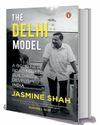
He does have a little more than an ordinary citizen's stake in it, having been instrumental in formulating the 'Atmanirbhar Bharat' and 'Vocal for Local' restructuring of India's economic policy during his days as the chief economic adviser. He followed this up with the longer-term 'Amrit Kaal 2047' blueprint for India becoming a developed nation.
It is also the foundation for his new book, India @100; Envisioning Tomorrow's Economic Powerhouse (Rupa). Currently executive director at the International Monetary Fund, Subramanian espouses his fervent belief that India is all set to grab this 'once-in-a-few-centuries' opportunity. Excerpts from an interview:
Q You have painted such a rosy picture of India's future in your book, like its GDP touching $55 trillion in 2047.
A. This outcome hinges on whether we can grow at 8 per cent from now on till 2047. Of course, I have portrayed other scenarios as well. Even if we grow at 7 per cent, we will be $40 trillion and, if we grow only at 6 per cent, we will still be $30 trillion.
If some risks manifest it is possible that growth may be lower. Eight per cent is ambitious but achievable especially given the demography we have, the kind of policies that have been implemented over the past 10 years, the public digital infrastructure, the innovation and the entrepreneurship.
Also, anywhere between twothirds to three-quarters of our economy is informal, and informal sector firms are far less productive than formal sector firms. So the emphasis on formalisation that is happening through the public digital infrastructure will be a key driver of productivity improvement.
And for the first time, we have entered the top 40 innovative countries list. So these will drive productivity improvements in the formal sector as well. When you put it all together, there are potential headwinds and potential tailwinds.
Diese Geschichte stammt aus der August 25, 2024-Ausgabe von THE WEEK India.
Starten Sie Ihre 7-tägige kostenlose Testversion von Magzter GOLD, um auf Tausende kuratierte Premium-Storys sowie über 8.000 Zeitschriften und Zeitungen zuzugreifen.
Bereits Abonnent ? Anmelden
Diese Geschichte stammt aus der August 25, 2024-Ausgabe von THE WEEK India.
Starten Sie Ihre 7-tägige kostenlose Testversion von Magzter GOLD, um auf Tausende kuratierte Premium-Storys sowie über 8.000 Zeitschriften und Zeitungen zuzugreifen.
Bereits Abonnent? Anmelden

Forging the future
As the curtain falls on 2024, I take pride in the extraordinary milestones achieved under the leadership of Prime Minister Narendra Modi. This year stands as a testament to the Modi government's resolve to forge a resilient and forward-looking Bharat. From groundbreaking advancements in infrastructure to visionary global initiatives, these efforts resonate deeply with the vision of Viksit Bharat.

Our strange democracy
Abraham Lincoln is lauded as among the very best presidents the US ever had: the statesman par excellence successfully steered the nation through the devastating and perilous years of the American civil war. Not only did Lincoln manage to keep his country united, he also ensured the passage of the 13th amendment to the US constitution, which abolished slavery.

Five years of post-pandemic fashion
It has been five years since we discovered what Covid-19 was, and five years since it disrupted the world forever. The World Health Organization activated their emergency systems on January 1, 2020, and informed the world by January 4, 2020. By the end of that week, they had set guidelines for various countries to follow. Comparable to the Spanish flu of 1918, more than 7 million people have died of Covid according to official data. Unofficially, no one has an idea. WHO has just this week asked China to provide critical data to understand the virus's origins as a “moral and scientific imperative”.

Community spirit
Rhythm of Dammam opens a window to the world of African-origin Siddis of Uttara Kannada

'Breaking' down a scandal
Society Girl is not just a case study of a high-profile death in Pakistan but also a stark commentary on media trials

Progress card
Jasmine Shah's book tells you what the AAP has achieved in Delhi in the last 10 years

SENSE IN NONSENSE
In his latest book of poetry, Ruskin Bond is at his funniest

Get ready for Trump bump
The ‘butterfly effect’ is a beautiful, mysterious metaphor of the planet’s interconnectedness.

QUIET FLOWS THE FAITH
The melding of an ancient amorphous faith and the latest science; of an antique tradition and new practices; ways of life older than memory and new expressions is happening at Prayagraj in Uttar Pradesh.

Trash to treasure
How a weed-choked Dal Lake spurred Maninder Singh's journey to become a waste management visionary